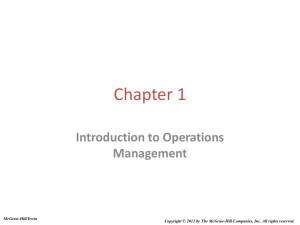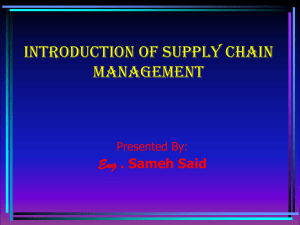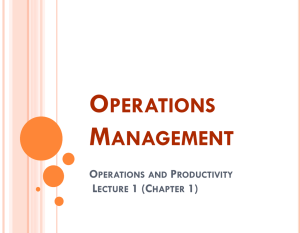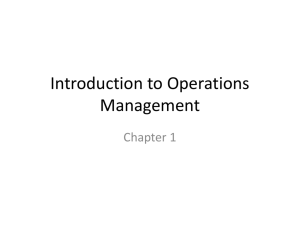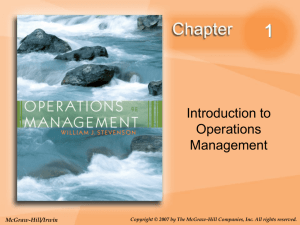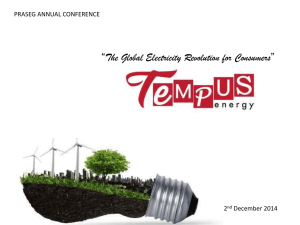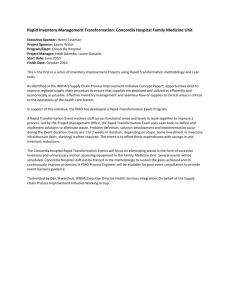Chapter 1, Heizer/Render, 5th edition
advertisement
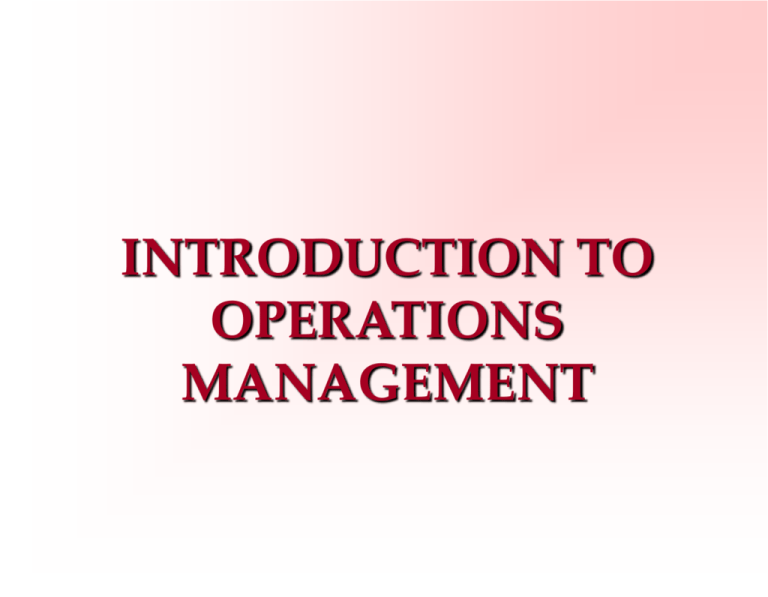
INTRODUCTION TO OPERATIONS MANAGEMENT OPERATIONS MANAGEMENT What is operations? The part of a business organization that is responsible for producing goods or services How can we define operations management? The design, operation and improvement of the systems or processes that create goods and/or provide services SUPPLY & DEMAND Operations & Supply Chains Supply Sales & Marketing > Demand Supply < Demand Supply = Demand Wasteful Costly Opportunity Loss Customer Dissatisfaction Ideal THE OPERATIONS FUNCTION Operations as a transformation process Operations as a basic function Operations as the technical core THE TRANSFORMATION PROCESS Value-Added Inputs •Land •Materials •Labor •Management •Capital •Information Transformation/ Conversion Process Outputs •Goods •Services Feedback Feedback Control Feedback Feedback = measurements taken at various points in the transformation process Control = The comparison of feedback against previously established standards to determine if corrective action is needed. WHAT IS VALUE ADDED? The essence of operations function is to add value during the transformation process Value added is the difference between the cost of intputs and the value or price of outputs. FIRMS USE THE MONEY GENERATED BY VALUE ADDED FOR: R&D Investment in new facilities and equipment Paying workers Paying for materials Paying for general expenses Profits TRANSFORMATION PROCESS OF A CANNED FOOD PROCESSOR Inputs Metal sheets Raw vegetables Water Energy Labor Building Equipment Processing Outputs Canned • Cleaning • Making cans vegetables • Cutting • Cooking • Packing • Labeling TRANSFORMATION PROCESS OF A HOSPITAL Inputs Doctors, nurses Hospital Medical Supplies Equipment Laboratories Processing Examination Surgery Monitoring Medication Therapy Outputs Healthy patients EXAMPLES OF VARIOUS OPERATIONS Operations Goods Producing Storage/ Transportation Exchange Entertainment Communication Examples Farming, mining, construction , manufacturing, power generation Warehousing, trucking, mail service, moving, taxis, buses, hotels, airlines Retailing, wholesaling, banking, renting, leasing, library, loans Films, radio and television, concerts, recording Newspapers, radio and television newscasts, telephone, satellites TYPES OF TRANSFORMATION PROCESSES Physical- manufacturing Locational- transportation Exchange- retailing Storage- warehousing Physiological- health care Informational- telecommunications Psychological- entertainment OPERATIONS AS A BASIC FUNCTION Marketing Generates demand gets customers Operations creates product or service Finance/Accounting Obtains funds Tracks organizational performance BASIC FUNCTIONS OF THE BUSINESS ORGANIZATION Organization Marketing Operations Finance SUPPLY CHAIN Supply Chain – a sequence of activities and organizations involved in producing and delivering a good or service Suppliers’ suppliers Direct suppliers Producer Distributor Final Customers IMPORTANCE OF OM (WHY STUDY OM?) (1 of 2) Operations is one of the three major functions of an organization Offers a major opportunity for an organization to improve its productivity and profitability OM affects 1) the companies’ ability to compete and 2) the nation’s ability to compete internationally Nearly half of the employed people over the world have jobs in operations IMPORTANCE OF OM (WHY STUDY OM?) (2 of 2) The OM function is responsible for a major portion of the assets of most organizations OM is a costly part of an organization The concepts, tools and techniques of OM are widely used in managing other functions. Presents career opportunities OPTIONS FOR INCREASING CONTRIBUTION Sales Cost of Goods Sold Gross Margin Finance Costs Net Margin Taxes @ 25% Contribution Finance & Accounting Marketing Option Option OM Option Sales Finance P roduction Current Revenue : +50% Costs: -50% Costs: -20% $100,000 $150,000 $100,000 $100,000 -80,000 -120,000 -80,000 -64,000 20,000 30,000 20,000 36,000 -6,000 -6,000 -3,000 -6,000 14,000 24,000 17,000 30,000 -3,500 -6,000 -4,250 -7,500 10,500 18,000 12,750 22,500 TYPES OF PRODUCTION PROCESSES (PROCESS FLOW STRUCTURES) INTERMITTENT Job shop Batch production CONTINOUS Mass production Continuous flow production PROJECT 18 EMERGENCY ROOM E.R.Triage room Patient A broken leg Patient B erratic pacemaker Hallway E.R. beds Pharmacy Billing/exit 19 AUTOMOBILE PLANT sequential Raw materials or customer Material and/or labor Station 1 Material and/or labor Station 2 Material and/or labor Station 3 Station 4 FG Material and/or labor Used for Repetitive or Continuous Processing 20 PRODUCTION OF GOODS VS. DELIVERY OF SERVICES MANUFACTURING vs. SERVICE Manufacturing and Service Organizations differ chiefly because manufacturing is goods-oriented and service is act-oriented. Goods Services Tangible Act-Oriented 22 GOODS-SERVICE CONTINUUM Products are typically neither purely service- or purely goods-based. Goods Services Surgery, Teaching Songwriting, Software Development Computer Repair, Restaurant Meal Home Remodeling, Retail Sales Automobile Assembly, Steelmaking 23 GOODS VS. SERVICES (1 of 3) CHARACTERISTICS GOODS SERVICE Customer contact Low High Uniformity of inputs and outputs High Low Labor content Low High Automation Easy Generally difficult Output Tangible Intangible, often unique Measurement of productivity Easy Difficult Opportunity to correct problems High Low Inventory Much Little Quality evaluation Easier Difficult Production activities Obvious Not so obvious GOODS VS. SERVICES (2 of 3) CHARACTERISTICS GOODS SERVICE Production and consumption Separate Location Centralized Locational factors to be considered Cost-oriented Generally take place at the same time Generally dispersed Revenue-oriented Reselling Possible Not possible Patentability Usually Not usually Activities Smooth and efficient Slower and awkward Inventoriability andTransportability Inventoriable Non inventoriable & and so Transportable nontransportable GOODS VS. SERVICES (3 of 3) CHARACTERISTICS GOODS SERVICE Job structure More structured Less structured Worker skill levels Generally higher Generally lower Employee turnover Generally lower Generally higher MANAGING SERVICES IS CHALLENGING Jobs in services are often less structured than in manufacturing Customer contact is generally much higher in services compared to manufacturing In many services, worker skill levels are low compared to those of manufacturing employees Services are adding many new workers in low-skill, entry-level positions Employee turnover is high in services, especially in low-skill jobs Input variability tends to be higher in many service environments than in manufacturing Service performance can be adversely affected by many factors outside of the manager’s control (e.g., employee and customer 27 attitudes) SERVICE JOB CATEGORIES (1 of 2) Governmental services Municipal services Trade services (wholesale/retail) Finance, insurance, real estate Medical (healthcare) Personal services SERVICE JOB CATEGORIES (2 of 2) Business services Education Food, lodging and entertainment Utilities and transportation Legal, consulting Repair SERVICES IN MANUFACTURING In manufacturing, services can be divided into two groups: Core Services Value-added Services CORE SERVICES Core services are basic things that customers want from products they purchase CORE SERVICES PERFORMANCE OBJECTIVES Quality Flexibility Operations Management Price (or cost Reduction) Speed VALUE-ADDED SERVICES Value-added services differentiate the organization from competitors and build relationships that bind customers to the firm in a positive way VALUE-ADDED SERVICE CATEGORIES Problem Solving Information Operations Management Field Support Sales Support PROCESS MANAGEMENT Process - one or more actions that transform inputs into outputs Three Categories of Business Processes: Upper-management These govern the operation of processes the entire organization. Operational These are core processes that processes make up the value stream. Supporting processes These support the core processes. 35 PROCESS VARIATION Four Sources of Variation: Variety of goods or services being offered The greater the variety of goods and services offered, the greater the variation in production or service requirements. Structural variation in demand These are generally predictable. They are important for capacity planning. Random variation Natural variation that is present in all processes. Generally, it cannot be influenced by managers. Assignable variation Variation that has identifiable sources. This type of variation can be reduced, or eliminated, by analysis and corrective action. Variations can be disruptive to operations and supply chain processes. They may result in additional costs, delays and shortages, poor quality, and inefficient work systems. 36 The Scope of OM: What Do Operations Managers Do? Plan - Organize - Staff - Lead - Control SCOPE OF OPERATIONS MANAGEMENT The scope of operations management ranges across the organization. The operations function includes many interrelated activities such as: – Forecasting – Capacity planning – Scheduling – Managing inventories – Assuring quality – Motivating employees – Deciding where to locate facilities – And more . . . 38 ROLE OF THE OPERATIONS MANAGER The Operations Function consists of all activities directly related to producing goods or providing services. A primary function of the operations manager is to guide the system by decision making. – System Design Decisions – System Operation Decisions 39 SYSTEM DESIGN DECISIONS System Design Decisions – Capacity – Facility location – Facility layout – Product and service planning – Process planning – Technology planning – Acquisition and placement of equipment These are typically strategic decisions that require • long-term commitment of resources • Determine parameters of system operation 40 SYSTEM OPERATION DECISIONS System Operation Decisions – Management of personnel – Inventory management and control – Scheduling – Project management – Quality assurance Operations managers spend more time on system operation decision than any other decision area but they still have a vital stake in system design 41 U.S. MANUFACTURING vs. SERVICE EMPLOYMENT Insert Figure 1.7 42 THE DECLINE IN MANUFACTURING EMPLOYMENT Productivity – Increasing productivity allows companies to maintain or increase their output using fewer workers Outsourcing – Some manufacturing work has been outsourced to more productive companies A Statistical Artifact – Manufacturers are increasingly using contract and temporary labor which no longer show up in the statistics as manufacturing employment 43 OPERATIONS MANAGEMENT AND DECISION MAKING Most operations decisions involve many alternatives that can have quite different impacts on costs or profits Typical operations decisions include: What: What resources are needed, and in what amounts? When: When will each resource be needed? When should the work be scheduled? When should materials and other supplies be ordered? Where: Where will the work be done? How: How will he product or service be designed? How will the work be done? How will resources be allocated? Who: Who will do the work? OPERATIONS MANAGEMENT AND DECISION MAKING Models Quantitative approaches Analysis of tradeoffs Systems approach Establishing priorities GENERAL APPROACH TO DECISION MAKING Modeling is a key tool used by all decision makers – Model - an abstraction of reality; a simplification of something. – Common features of models: They are simplifications of real-life phenomena They omit unimportant details of the reallife systems they mimic so that attention can be focused on the most important 46 aspects of the real-life system MODELS Types of Models: – Physical Models Look like their real-life counterparts – Schematic Models Look less like their real-life counterparts than physical models – Mathematical Models Do not look at all like their real-life counterparts UNDERSTANDING MODELS Keys to successfully using a model in decision making – What is its purpose? – How is it used to generate results? – How are the results interpreted and used? – What are the model’s assumptions and limitations? 48 BENEFITS OF MODELS Models are generally easier to use and less expensive than dealing with the real system Require users to organize and sometimes quantify information Provide a systematic approach to problem solving Increase understanding of the problem Enable managers to analyze “What if?” questions Enable managers to specify objectives Serve as a consistent tool for evaluation and provide a standardized format for analyzing a problem Enable users to bring the power of mathematics to bear on a problem. MODEL LIMITATIONS Quantitative information may be emphasized at the expense of qualitative information Models may be incorrectly applied and the results misinterpreted This is a real risk with the widespread availability of sophisticated, computerized models are placed in the hands of uninformed users. The use of models does not guarantee good decisions. QUANTITATIVE APPROACHES (ANALYTICAL TOOLS USED IN OM) A decision making approach that frequently seeks to obtain a mathematically optimal solution Linear programming Queuing techniques Forecasting techniques Inventory models Project models Statistical models Simulation Decision analysis METRICS AND TRADE-OFFS Performance Metrics – All managers use metrics to manage and control operations Profits Costs Productivity Forecast accuracy Analysis of Trade-Offs – A trade-off is giving up one thing in return for something else Carrying more inventory (an expense) in order to achieve a greater level of customer service Tradeoffs 52 ESTABLISHING PRIORITIES In nearly all cases, certain issues or items are more important than others Recognizing this allows managers to focus their attention to those efforts that will do the most good 53 ESTABLISHING PRIORITIES: PARETO PHENOMENON Pareto Phenomenon - a few factors account for a high percentage of occurrence of some event(s) The critical few factors should receive the highest priority 80/20 Rule- 80% of the problems are caused by 20% of the activities This is a concept that is appropriately applied to all areas and levels of management How do we identify the vital few? 54 SYSTEMS APPROACH System - a set of interrelated parts that must work together The business organization is a system composed of subsystems marketing subsystem operations subsystem finance subsystem The systems approach Emphasizes interrelationships among subsystems Main theme is that the whole is greater than the sum of its parts The output and objectives of the organization take precedence over those of any one subsystem 55 DEGREE OF CUSTOMIZATION Relative to other standardized products and services customized products: Tend to be more labor intensive Tend to be more time consuming Tend to require more highly-skilled people Tend to require more flexible equipment Have much lower volume of output Have higher price tags Degree of customization has a significant influence on the entire organization Process selection Job design Affects marketing, sales, accounting, finance, and 56 information systems ETHICAL ISSUES IN OPERATIONS Ethical issues arise in many aspects of operations management: Financial statements Worker safety Product safety Quality The environment The community Hiring and firing workers Closing facilities Workers rights 57 THE HISTORICAL EVOLUTION OF OPERATIONS MANAGEMENT HISTORICAL EVENTS IN OM Industrial Revolution (1770s) Scientific Management (1911) Human Relations Movement (1920-1960) Decision Models – Management Science (1915, 1940-70s) Influence of Japanese Manufacturers-Quality Revolution & JIT (1970s-1990s ) Globalization (1970s- ) Information Age/Internet Revolution (1990s-) INDUSTRIAL REVOLUTION Pre-Industrial Revolution – Craft production - System in which highly skilled workers use simple, flexible tools to produce small quantities of customized goods Some key elements of the industrial revolution – Began in England in the 1770s – Division of labor - Adam Smith, 1776 – Application of the “rotative” steam engine, 1780s – Cotton Gin and Interchangeable Parts - Eli Whitney, 1792 Management theory and practice did not advance appreciably during this period 60 SCIENTIFIC MANAGEMENT Movement was led by efficiency engineer, Frederick Winslow Taylor – Believed in a “ Science of Management” based on observation, measurement, analysis and improvement of work methods, and economic incentives – Management is responsible for planning, carefully selecting and training workers, finding the best way to perform each job, achieving cooperate between management and workers, and separating management activities from work activities – Emphasis was on maximizing output 61 SCIENTIFIC MANAGEMENTCONTRIBUTORS Frank Gilbreth - father of motion studies Henry Gantt - developed the Gantt chart scheduling system and recognized the value of non-monetary rewards for motivating employees Harrington Emerson - applied Taylor’s ideas to organization structure Henry Ford - employed scientific management techniques to his factories Moving assembly line Mass production 62 HUMAN RELATIONS MOVEMENT The human relations movement emphasized the importance of the human element in job design – Lillian Gilbreth – Elton Mayo – Hawthorne studies on worker motivation, 1930 – Abraham Maslow – Motivation theory, 1940s; Hierarchy of Needs, 1954 – Frederick Hertzberg – Two Factor Theory, 1959 – Douglas McGregor – Theory X and Theory Y, 1960s – William Ouchi – Theory Z, 1981 63 DECISION MODELS AND MANAGEMENT SCIENCE F.W. Harris – Mathematical Model for Inventory Management, 1915 Dodge, Romig, and Shewart – Statistical Procedures for Sampling and Quality Control, 1930s Tippett – Statistical Sampling Theory, 1935 Operations Research (OR) Groups – OR applications in Warfare George Dantzig – Linear Programming, 1947 64 INFLUENCE OF JAPANESE MANUFACTURERS Refined and developed management practices that increased productivity – Credited with fueling the “quality revolution” – Just-in-Time production 65 EXCITING NEW CHALLENGES IN OPERATIONS MANAGEMENT NEW TRENDS AND ISSUES IN OM Mass Customization Supply Chain Management Outsourcing Lean manufacturing Agility E-Business and E-Commerce Management of Technology Globalization Ethical Behavior NEW CONCEPTS AND TRENDS: MASS CUSTOMIZATION The rapid, low cost production of goods and services that fulfill constantly changing and increasingly unique customer desires. 68 NEW CONCEPTS AND TRENDS: SUPPLY CHAIN MANAGEMENT The management of the sequence of organizations- their facilities, functions and activities- that are involved in producing and delivering a product or service SCM requires the application of a systems approach to managing the flow of information, materials and services from raw material suppliers through factories and warehoses to the end user (customer) THE NEED FOR MANAGING THE SUPPLY CHAIN In the past, organizations did little to manage the supply chain beyond their own operations and immediate suppliers which led to numerous problems such as: Oscillating inventory levels Inventory stockouts Late deliveries Quality problems 70 A SUPPLY CHAIN FOR BREAD Value Added Value of Product Farmer produces and harvests wheat $0.15 $0.15 Wheat transported to mill $0.08 $0.23 Mill produces flour $0.15 $0.38 Flour transported to baker $0.08 $0.46 Baker produces bread $0.54 $1.00 Bread transported to grocery store $0.08 $1.08 Grocery store displays and sells bread $0.21 $1.29 Total Value-Added $1.29 Stage of Production ELEMENTS OF SUPPLY CHAIN MANAGEMENT (1 of 2) Customers – what products/services do customers want Forecasting – predicting timing and volume of customer demand Design – incorporating customer wants, manufacturability, and time to market Capacity planning – matching supply and demand Processing – controlling quality, scheduling work 72 ELEMENTS OF SUPPLY CHAIN MANAGEMENT (2 of 2) Inventory – meeting demand requirements while managing costs Purchasing – evaluating potential suppliers, supporting the needs of operations on purchased goods and services Suppliers – monitoring supplier quality, on-time delivery, and flexibility; maintaining supplier relations Location – determining the location of facilities Logistics – deciding how to best move information and materials$ 73 NEW CONCEPTS AND TRENDS: OUTSOURCING Buying goods or services rather than producing goods or performing services within the organization NEW CONCEPTS AND TRENDS: LEAN MANUFACTURING Systems that use minimal amounts of resources less space, less inventory, fewer workers, fewer levels of management- to produce a high volume of high-quality goods with some variety An adaptation of mass production that prizes quality and flexibility Incorporates advantages of mass production (high volume, low unit cost) and craft production (variety and flexibility) NEW CONCEPTS AND TRENDS: AGILITY The ability of an organization to respond quickly to demands or opportunities. Involves maintaining a flexible system that can quickly respond to changes in either the volume of demand or changes in product/service offerings NEW CONCEPTS AND TRENDS: ELECTRONIC COMMERCE The use of computer networks, primarily the internet, to buy and sell products, services, and information. OTHER TRENDS (1 of 2) Enhancing Value-Added Services Management of Technology Emphasis on Operations Strategy Increasing Emphasis on Cost Control and Productivity Improvement Quality and Process Improvements Increasing emphasis on business and social responsibility OTHER TRENDS (2 of 2) Developing flexible supply chains to enable mass customization of products and services Achieving the Service Factory GLOBALIZATION GLOBALIZATION CAN TAKE THE FORM OF: Selling in foreign markets Producing in foreign lands Purchasing from foreign suppliers Partnering with foreign firms REASONS TO GLOBALIZE OPERATIONS (1 of 2) To take advantage of favorable costs To gain access to and attract international markets To build reliable sources of supply To improve the supply chain To be more responsive to changes in demand REASONS TO GLOBALIZE OPERATIONS (2 of 2) To provide better goods and services To learn to improve operations To attract and retain global talent To keep abreast of the latest trends and technologies EXAMPLES OF GLOBAL STRATEGIES Boeing – both sales and production are worldwide. Benetton – moves inventory to stores around the world faster than its competitor by building flexibility into design, production, and distribution Sony – purchases components from suppliers in Thailand, Malaysia, and around the world GM is building four similar plants in Argentina, Poland, China, and Thailand SOME MULTINATIONAL CORPORATIONS (1 of 3) Company Nestlé Nokia Philips Bayer ABB SAP Exxon Mobil Royal Dutch/Shell IBM McDonald’s Country of Origin Switzerland Finland Netherlands Germany Germany Germany United States Netherlands United States United States Foreign Sales as % of Total 98.2 97.6 94.0 89.8 87.2 80.0 79.6 73.3 62.7 61.5 SOME MULTINATIONAL CORPORATIONS (2 of 3) Company Home Country % Sales % Assets Outside Outside Home Home Country % Foreign Workforce Country Citicorp USA 34 46 NA ColgatePalmolive USA 72 63 NA Dow Chemical Gillette USA 60 50 NA USA 62 53 NA Honda Japan 63 36 NA IBM USA 57 47 51 SOME MULTINATIONAL CORPORATIONS (3 of 3) Company Home Country % Sales Outside Home Country % Assets Outside Home Country % Foreign Workforce ICI Britain 78 50 NA Nestlé Switzerland 98 95 97 Philips Netherlands 94 Electronics Siemens Germany 51 85 82 NA 38 Unilever 70 64 Britain & Netherlands 95 BOEING SUPPLIERS Firm Country Parts Alenia Italy Wing flaps AeroSpace Technologies CASA Fuji Australia Rudder Spain Japan GEC Avionics United Kingdom Korean Air Korea MenascoAerospace Canada Ailerons Landing gear doors, wing section Flight computers Flap supports Landing gears Short Brothers Ireland Landing gear doors Singapore Aerospace Singapore Landing gear doors AN INTERNATIONAL COMPARISON OF HOURLY WAGE RATES $ 35 – $ 30 – $ 25 – Germa Japan United EU $ 20 – $ 15 – $ 10 – $5– $0– | 1975 | 1980 | 1985 | 1990 | 1995 Asian Mexic | 2000 COMPETITIVENESS COMPETITIVENESS The degree to which a nation can produce goods and services that meet the test of international markets while simultaneously maintaining or expanding the real incomes of its citizens. COMPETITIVENESS OF SELECTED COUNTRIES 100 80 60 40 20 0 US Singapore Finland Ireland Germany UK Japan Mexico Russia
